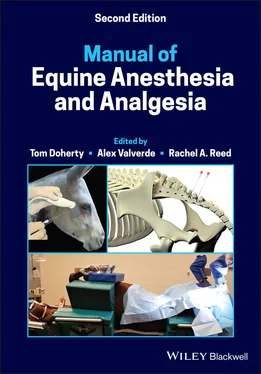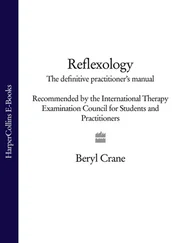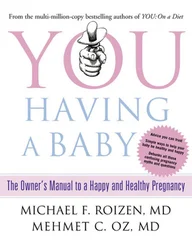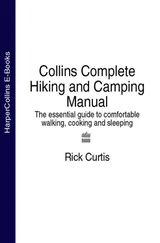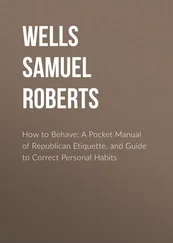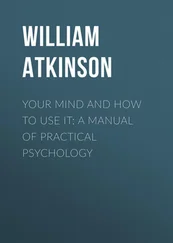Surgeries performed between midnight and 6 a.m. carry the highest risk of mortality. This may be due to the nature of the emergency, as well as to staff shortages and personnel fatigue.
Dorsal recumbency was found to increase risk compared to either lateral recumbency, but most “colic” surgeries are performed with the horse in dorsal recumbency.
An increased risk of postanesthetic myelopathy has mostly been associated with draft breeds between 6 and 24 months of age and dorsal recumbency.
Using total inhalational anesthesia regimen in foals (<12 months of age) without premedication carries the highest risk.
Halothane sensitizes the myocardium to circulating catecholamines. Fewer cardiac arrests occurred when isoflurane was substituted for halothane, although overall mortality did not differ between groups because limb fracture in recovery was prevalent for the isoflurane group.
Isoflurane and sevoflurane may be associated with unsatisfactory recovery, and sedation is often used following anesthesia to reduce the risk of excitable recovery.
Use of isoflurane and sevoflurane was linked with increased mortality, but this was because these drugs are more likely to be selected for sick horses.
Not using any premedication is associated with the highest risk, probably owing to increased circulating catecholamines from stress. It may be prudent to premedicate foals before induction of anesthesia, especially when using halothane.
Acepromazine lowers the risk of mortality when used alone as a premedicant, because it reduces the incidence of ventricular arrhythmias in the presence of halothane.
No particular injectable induction regimen is associated with greater risk when used with inhalational anesthesia.
Total intravenous anesthesia (TIVA) is associated with the lowest risk of all, but TIVA is often used for short procedures. TIVA has been associated with reduced stress response.
F Duration and management of anesthesia
Long periods of anesthesia (>2 hours) with volatile anesthetics are often associated with cardiovascular depression and poor tissue perfusion, leading to problems such as cardiac arrest or postanesthetic myopathy.
Intraoperative hypotension during anesthesia has clearly been associated with postanesthetic myopathy, and can still occur with short anesthetic periods. Direct arterial pressure monitoring should be used during lengthy anesthetic periods.
Postanesthetic myopathy may lead to bone fracture or dislocation.
Postanesthetic airway obstruction and pulmonary edema may be prevented by keeping the head in a normal position thereby reducing the risk of laryngeal nerve paralysis, and with good airway management in the recovery period.
1 Arndt, S., Hopster, K., Sill, V. et al. (2020). Comparison between head‐tail‐rope assisted and unassisted recoveries in healthy horses undergoing general anesthesia for surgeries. Vet. Surg. 49: 329–338.
2 Bidwell, L.A., Bramlage, L.R., and Rood, W.A. (2007). Equine perioperative fatalities associated with general anaesthesia. Vet. Anaesth. Analg. 34: 23–30.
3 Niimura del Barrio, M.C., David, F., Hughes, J.M.L. et al. (2018). A retrospective report (2003–2013) of the complications associated with the use of a one‐man (head and tail) rope recovery system in horses following general anaesthesia. Ir. Vet. J. 71: 1–9.
4 Curto, E.M., Griffith, E.H., Posner, L.P. et al. (2018). Factors associated with postoperative complications in healthy horses after general anesthesia for ophthalmic versus non‐ophthalmic procedures: 556 cases (2012–2014). J. Am. Vet. Med. Assoc. 252: 1113–1119.
5 Donaldson, L.J., Dunlop, C.S., Holland, M.S., and Burton, B.A. (2000). The recovery of horses from inhalant anesthesia: a comparison of halothane and isoflurane. Vet. Surg. 29: 92–101.
6 Dugdale, A.H.A. and Taylor, P.M. (2016). Equine anaesthesia‐associated mortality: where are we now? Vet. Anaesth. Analg. 43: 242–255.
7 Dugdale, A.H.A., Obhrai, J., and Cripps, P.J. (2016). Twenty years later: a single‐centre, repeat retrospective analysis of equine perioperative mortality and investigation of recovery quality. Vet. Anaesth. Analg. 43: 171–178.
8 Duke, T., Filsek, U., and Read, M.R. (2006). Clinical observations surrounding an increased incidence of post‐anesthetic myopathy in halothane‐anesthetized horses. Vet. Anaesth. Analg. 33: 122–127.
9 Grandy, J.L., Steffey, E.P., Hodgson, D.S., and Woliner, M.J. (1987). Arterial hypotension and the development of postanesthetic myopathy in halothane‐anesthetized horses. Am. J. Vet. Res. 48: 192–197.
10 Johnston, G.M., Taylor, P.M., Holmes, M.A., and Wood, J.L.N. (1995). Confidential enquiry of perioperative equine fatalities (CEPEF‐1): preliminary results. Equine. Vet. J. 27: 193–200.
11 Johnston, G.M., Eastment, J.K., Wood, J.L.N., and Taylor, P.M. (2002). The confidential enquiry into perioperative equine fatalities (CEPEF): mortality results of phases 1 and 2. Vet. Anaesth. Analg. 29: 159–170.
12 Johnston, G.M., Eastment, J.K., Taylor, P.M. et al. (2004). Is isoflurane safer than halothane in equine anaesthesia? Results from a prospective multicenter randomized controlled trial. Equine. Vet. J. 36: 64–71.
13 Leece, L., Corletto, F., and Brearley, J.C. (2008). A comparison of recovery times and characteristics with sevoflurane and isoflurane anaesthesia in horse undergoing magnetic resonance imaging. Vet. Anaesth. Analg. 35: 383–391.
14 Parviainen, A.K.J. and Trim, C.M. (2000). Complications associated with anaesthesia for ocular surgery: a retrospective study 1989‐1996. Equine. Vet. J. 32: 555–559.
15 Ragle, C., Baetge, C., Yiannikouris, S. et al. (2011). Development of equine post anesthetic myelopathy: thirty cases (1979‐2010). Equine. Vet. Educ. 23: 630–635.
16 Santos, M., Fuente, M., Garcia‐Iturralde, P. et al. (2003). Effects of alpha2 adrenoceptor agonists during recovery from isoflurane anaesthesia in horses. Equine. Vet. J. 35: 170–175.
17 Senior, M. (2005). Post‐anesthetic pulmonary oedema in horses: a review. Vet. Anaesth. Analg. 32: 193–200.
18 Young, S.S. and Taylor, P.M. (1990). Factors leading to serious anaesthetic related problems in equine anaesthesia. J. Ass. Vet. Anaesth. 17: 59. (abstr).
19 Young, S.S. and Taylor, P.M. (1993). Factors influencing the outcome of equine anaesthesia: a review of 1,314 cases. Equine. Vet. J. 25: 147–151.
Tanya Duke‐Novakovski
I Preparation of the horse
A Evaluation
History and physical examination findings help with evaluation of health.
Many emergency cases, especially intestinal emergencies, are in cardiovascular shock and must be stabilized as much as possible prior to induction of anesthesia.
In normal horses undergoing elective surgery, there is generally no value in performing extensive laboratory tests.
In emergency cases, performing laboratory tests such as electrolyte and metabolic acid‐base status may be vital to the management of the case (e.g. a foal with uroabdomen).
During the examination, attention should be directed to the neurological, cardiovascular, and respiratory systems.
Musculoskeletal problems, which may affect recovery, should be considered, and a plan should be made to assist recovery if deemed necessary.
May reveal information that affects case management.
A recent history of coughing may indicate a viral infection of the airway, in which case elective surgeries should be postponed until one month following resolution of clinical signs.
Читать дальше
